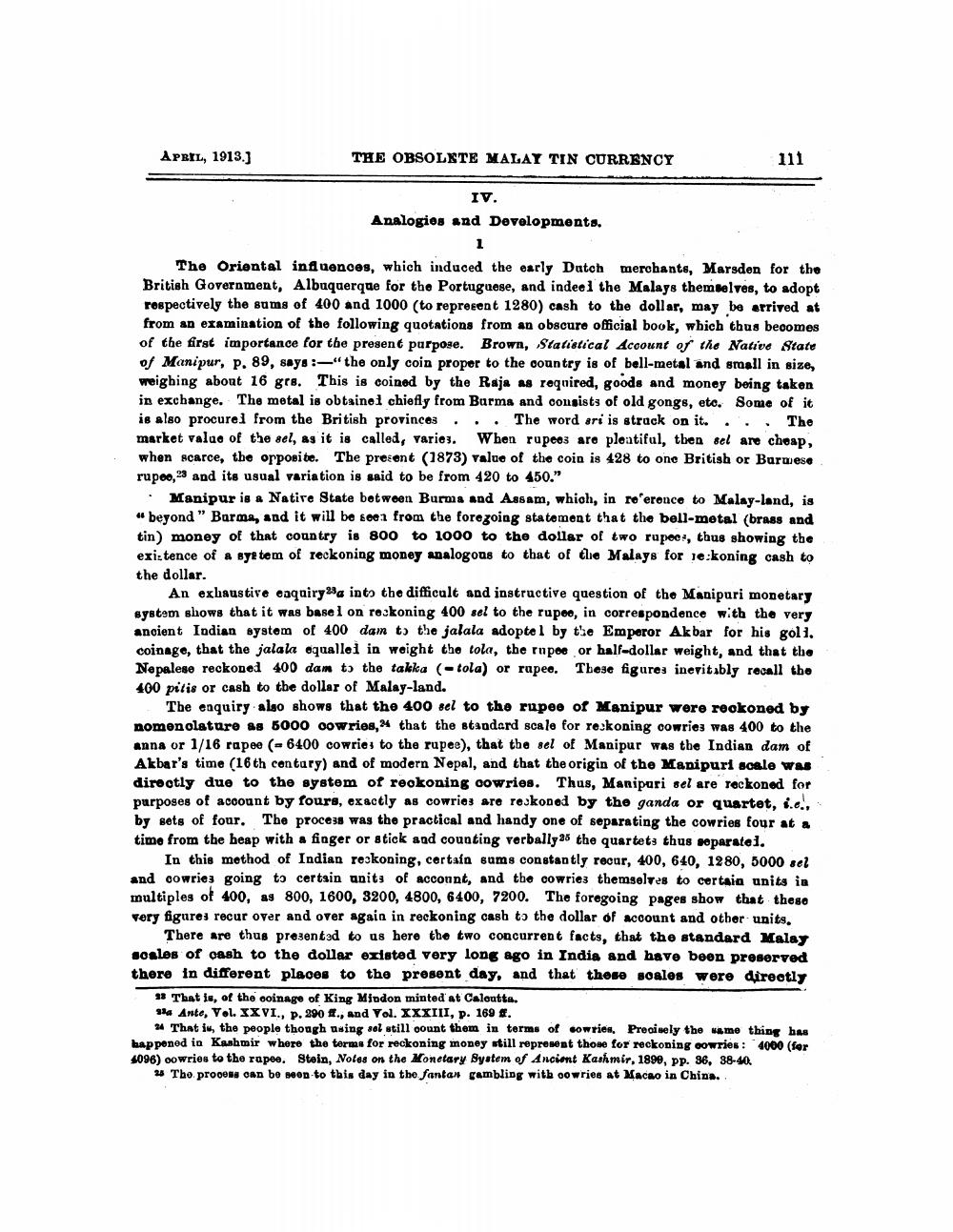________________
APRIL, 1913.)
THE OBSOLETE MALAY TIN CURRENCY
111
IV. Analogies and Developments,
1
The Oriental influences, which induced the early Datoh merchants, Marsden for the British Government, Albuquerque for the Portuguese, and indeel the Malays themselves, to adopt respectively the sums of 400 and 1000 (to represent 1280) cash to the dollar, may be arrived at from an examination of the following quotations from an obscure official book, which thus becomes of the first importance for the present purpose. Brown, Statistical Account of the Native State of Manipur, p. 89, says :-"the only coin proper to the country is of bell-metal and small in size, weighing about 16 grs. This is coined by the Raja as required, goods and money being taken in exchange. The metal is obtainel chiefly from Burma and consists of old gongs, etc. Some of it is also procured from the British provinces ... The word sri is strack on it... The market value of the sel, as it is called, variou. When rupees are pleatiful, then sel are cheap, when scarce, the opposite. The present (1873) value of the coin is 428 to one British or Baruese rupoo, and its usual variation is said to be from 420 to 450."
• Manipur is a Natire State between Barma and Assam, which, in re'erence to Malay-land, is " beyond " Barma, and it will be seen from the foregoing statement that the bell-metal (brass and tin) money of that country is 800 to 1000 to the dollar of two rupec, thus showing the exiz tence of a system of reckoning money analogous to that of the Malays for je:koning cash to the dollar.
An exhaustive enquiry into the difficult and instructive question of the Manipuri monetary system shows that it was basel on reskoning 400 sel to the rupeo, in correspondence with the very ancient Indian system of 400 dan to the jalala adoptel by the Emperor Akbar for his goli. coinage, that the jalala squalloi in weight the tola, the rnpoo or half-dollar weight, and that the Nepalese reckoned 400 dan to the takka (-tola) or rapee. These figures inevitably recall the 400 pilis or cash to the dollar of Malay-land.
The eaquiry also shows that the 400 sel to the rupeo of Manipur were reckoned by nomenolature as 5000 oowries, 24 that the standard scale for reskoning cowries was 400 to the anna or 1/16 rapee (-6400 cowries to the rupee), that the sel of Manipur was the Indian dam of Akbar's time (16th centary) and of modern Nepal, and that the origin of the Manipuri scale was directly due to the system of reckoning cowries. Thus, Manipuri sel are reckoned for purposes of account by fours, exactly as cowries are reckoned by the ganda or quartet, i..., by sets of four. The process was the practical and handy one of separating the cowries four at a time from the heap with a finger or stick and counting verbally as the quartets thus separated.
In this method of Indian reskoning, certain sums constantly recur, 400, 640, 1280, 5000 sel and cowrie: going to certain units of account, and the cowries themselves to certain units in multiples of 400, as 800, 1600, 3200, 4800, 6400, 7200. The foregoing pages show that these very figures recur over and over again in reckoning cash to the dollar of account and other units.
There are thus presented to us here the two concurrent facts, that the standard Malay sosles of cash to the dollar existed very long ago in India and have been preserved there in different places to the present day, and that these soales were directly
13 That is, of the coinage of King Mindon minted at Caloutta. Ila Ante, Vol. XXVI., P. 290 f., and Vol. XXXIII, p. 169 #.
24 That is, the people though asing sol still count them in terms of sowries. Precisely the same thing has bappened in Kashmir where the terms for reckoning money still represent those for reckoning cowries : 4000 (for 1096) cowries to the rapee. Stein, Notes on the Monetary System of Ancient Kashmir, 1890, PP. 36, 38-40
25 Tho process can be soon to this day in the fantan gambling with oowries at Macao in China.




